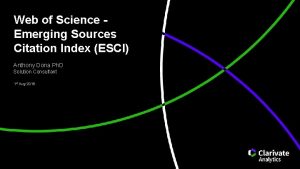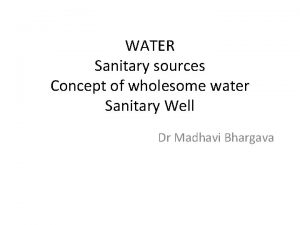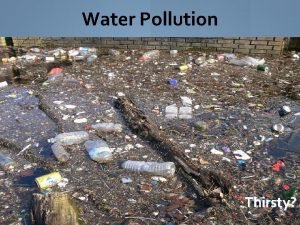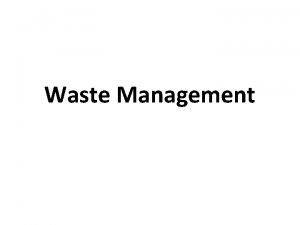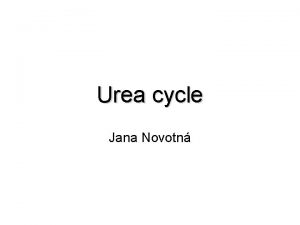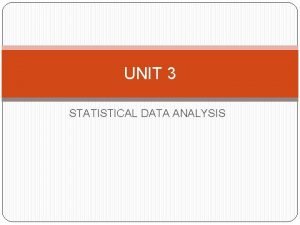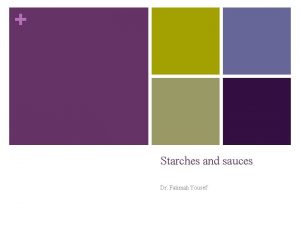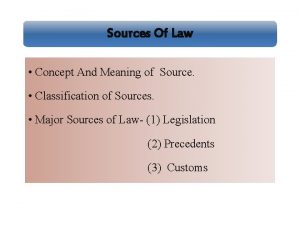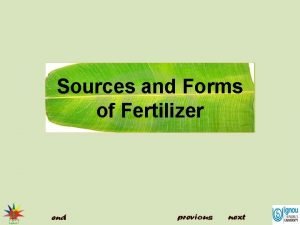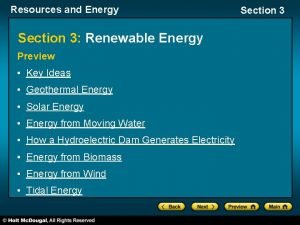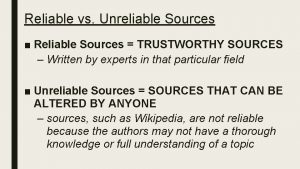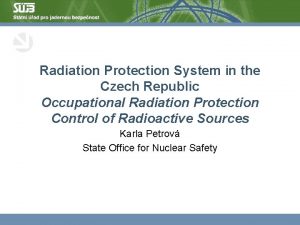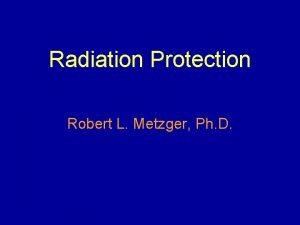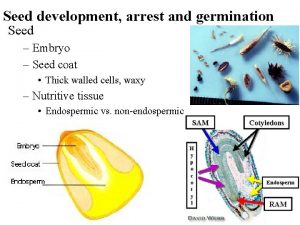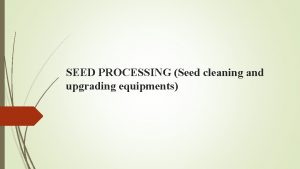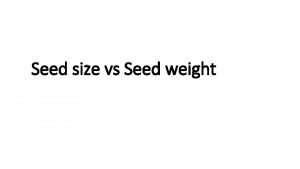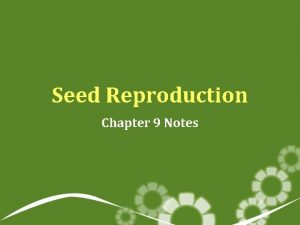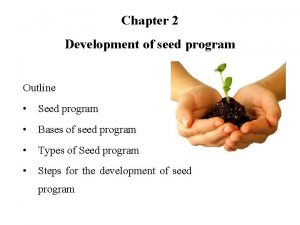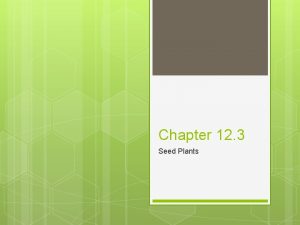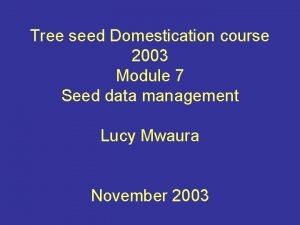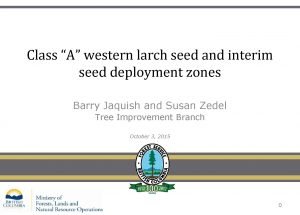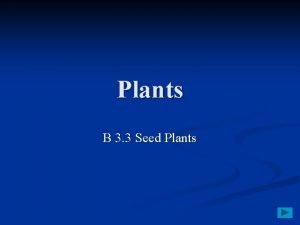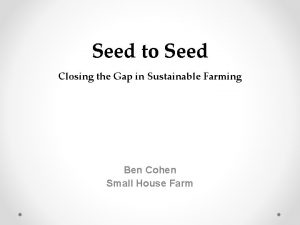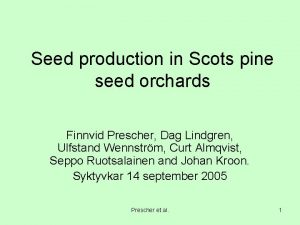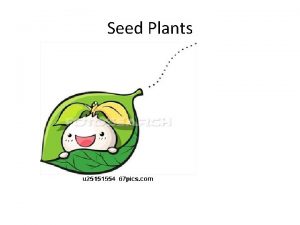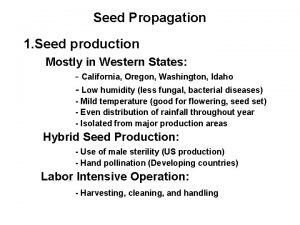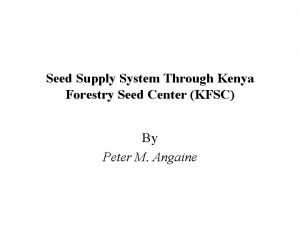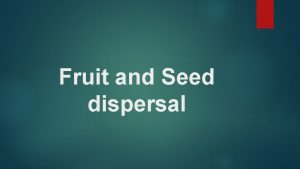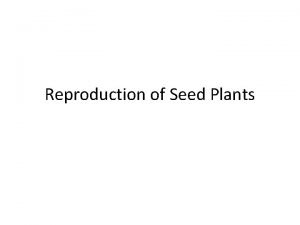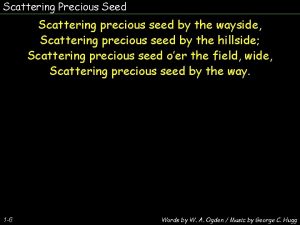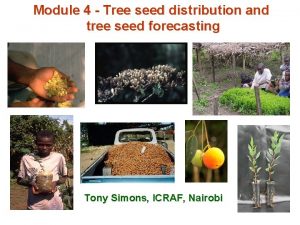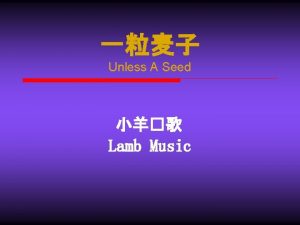Chapter 6 Sources of seed Sources of seed












































- Slides: 44

Chapter 6 Sources of seed

Sources of seed • Grass, vegetables & flower seeds produced in areas with low summer rainfall, low humidity and limited rain during harvest • Reduces disease • Sources: – Pacific Northwest, California, South and Central America and Australia – Seed exchanges, collection trips, seed orchards, arboreta & botanic gardens




Seed Exchange http: //www. seedsavers. org/

http: //www. southernexposure. com/

Sources of seed • Harvesting and processing – Types of fruits • Dry fruits - most Ag. crops (corn, wheat) do NOT dehisce (“split-open”)

Sources of seed • Harvesting and processing – Types of fruits • Dry seeds - from fruits that dehisce (pods, capsules, cones)

Sources of seed • Harvesting and processing – Types of fruits • Fleshy fruits - fruits & vegetables crops (berries, pomes, drupes)

Sources of seed – Procedures (dry fruits & seeds) • Drying • Extraction • Seed conditioning (sieves for cleaning) – Procedures (fleshy fruits) • Extraction -water soak, screen, scoop • Fermentation - macerate fruit, soak for up to 4 days @ 70°F (use caution as heat and wet conditions can cause germ. ) • Floatation - heavy seed sinks (good), pulp and unfilled seeds float (bad) • Blenderize - cover blades with plastic tubing, add water • Dry immediately (except seeds of recalcitrant plants)



Sources of seed • Seed testing – Regulated by State and Federal law – Seed Act of 1939 (if shipped between states) – Shipper must provide a label containing: • • • Name (including cultivars) Origin Germination % % pure seed Other seed included (weed seeds) Inert materials (rocks, dirt, etc. )



Sources of seed • Sampling – Composite samples (collected from several bags) – Submitted sample (what is sent to be tested) – Working sample (what is actually tested)

Sources of seed • Germination tests – Use 400+ seeds – Divide into lots of 100 – If germination of lots differ by >10%, retest 100 100

Sources of seed • Blotter or germination papers – Free from toxins • Rolled “towel” test - for cereal grains • Seed rating – Normal seed/seedling – Hard seed - have not absorbed water – Dormant seed/non-viable - firm and imbibed – Abnormal seedling - improper shoot/root growth – Dead/decaying seeds


Sources of seed • Excised embryo test – For woody trees & shrubs (because they have a long after-ripening period) – Remove seed coat and endosperm which contain germination inhibitors – Can do on blotters or filter paper – Provide light – 64 - 74°F

Sources of seed • Tetrazolium test (developed in 1949) – Biochemical method – 2, 3, 5 -triphenyltetrazolium chloride (TTC) which is colorless. Chemical Formula: C 19 H 15 CIN 4 – Living tissue with active dehydrogenase enzyme (this removes 2 electrons and a proton from the substrate molecule!) to produce formazan (red pigment) – Quick test – Embryo must be relatively large to see results

Sources of seed • X-ray analysis – Does not test for viability – Checks for filled seeds – Checks for insects – Seeds must be > 2 mm

Sources of seed • Purity tests – % by weight of pure seed present in the sample – Physically pure (no soil, debris, etc. ) – Genetically “pure” • Checked by DNA fingerprinting

Sources of seed • Vigor tests – Not required by law – Checks for the rapid and uniform emergence and development of seedlings under a range of environmental conditions

Sources of seed • Vigor tests – Types: • Accelerated aging (105 - 110ºF + 100% RH) for 2 - 5 days • Cold test (used for warm-temp. crops like corn), imbibe and hold seed at 50ºF for 7 days then plant at 75ºF ) • Cool test (for veggies and flower seed), germinate at 64ºF • Electrolyte leakage increases as seed deteriorate. Measure using conductivity meter

Sources of seed • Seed treatments – Seed protectants • Chemical treatments - powders. liquid, slurry – Copper sulfate (1800’s) – Mercury compounds (1900’s) - banned in 1980’s – Fungicides (1940 -50 to present) Captan and Thiram • Biocontrol – Beneficial microbes (bacteria and fungi)

Sources of seed • Seed treatments – Seed protectants • Thermotherapy – Hot water (120 -135°F) for 15 -30 minutes – Kills insects and some diseases – Seed cannot be previously hydrated! • Seed coating – Pelletized (1000% heavier) – Film-coated (1 -5% heavier)

Thiram treated seed

Pelletized petunia seed

Sources of seed • Germination enhancement – Primed seed (lettuce and pansy) – Pregerminated - sow using fluid drilling – Regerminated - seed will resprout after drying completely following germination (rare)

Sources of seed • Seed storage duration – Recalcitrant or short-lived seeds • Spring-ripening temperate trees (like some Acer, Populus, Salix, Ulmus) • Nut trees (Aesculus, Carya, Corylus, Castanea, Fagus, Jugans, Quercus) • Tropical plants • Aquatic plants





Sources of seed • Orthodox seed – Medium-lived seeds (2 -15 years) • Low RH and low temp. – Long-lived seeds (15 - 100 years) • Lotus seed that germinated was 100 -430 years old !



Sources of seed • Storage factors – Moisture content *** most important factor for longevity! • 4 -6% for storage • 40 -60% for germination • Recalcitrant seeds are sensitive to low moisture storage and therefore require >40% & cool temps. – Temperature • Subfreezing to 32ºF + low moisture (except for tropical and sub-tropical plants!)

Sources of seed • Cryopreservation – Uses liquid nitrogen (-196°C or -320°F) – Seed must be dry before freezing • Containers – Aluminum pouches – Aluminum cans – 3 mil polyethylene – Aluminum-lined paper – Desiccant = silica gel with cobalt chloride as an indicator (blue = dry, pink = > 45% RH)



 Print sources and web sources
Print sources and web sources The importance of water resources
The importance of water resources Chapter 2 income sources
Chapter 2 income sources Path length difference
Path length difference Sources and uses of funds
Sources and uses of funds Example of citing sources
Example of citing sources Emerging sources citation index means
Emerging sources citation index means Source of contamination
Source of contamination Define the term safe and wholesome water
Define the term safe and wholesome water Examples of point source pollution
Examples of point source pollution Sources of waste
Sources of waste Urea amino acids
Urea amino acids Sources of hypothesis
Sources of hypothesis Sources of personality
Sources of personality Lindisfarne raid primary sources
Lindisfarne raid primary sources Divine source theory of language
Divine source theory of language The real macbeth
The real macbeth Errors in analytical chemistry
Errors in analytical chemistry 6 sources of influence
6 sources of influence Syndicated services collect and supply data against a fee
Syndicated services collect and supply data against a fee Storage of starch and sauces
Storage of starch and sauces Reliable vs unreliable sources
Reliable vs unreliable sources Source of law
Source of law Asylum case summary
Asylum case summary Source of heat
Source of heat Source of finance
Source of finance Advantage of retained profit
Advantage of retained profit Sources of biopotential
Sources of biopotential What are the sources of authority?
What are the sources of authority? Mixed fertilizer ppt
Mixed fertilizer ppt Scientific revolution primary sources
Scientific revolution primary sources Section 3 renewable energy sources
Section 3 renewable energy sources Sources of research problem
Sources of research problem What are the sources of research problem
What are the sources of research problem Renewable source of energy definition
Renewable source of energy definition Reliable vs unreliable sources
Reliable vs unreliable sources Reliable vs unreliable sources
Reliable vs unreliable sources Define recuritment
Define recuritment Recruitment objectives
Recruitment objectives Selection introduction
Selection introduction Sources of graphics
Sources of graphics Ionizing radiation sources
Ionizing radiation sources Ionizing radiation sources
Ionizing radiation sources Uncw jstor
Uncw jstor Primary evidence vs secondary evidence
Primary evidence vs secondary evidence






